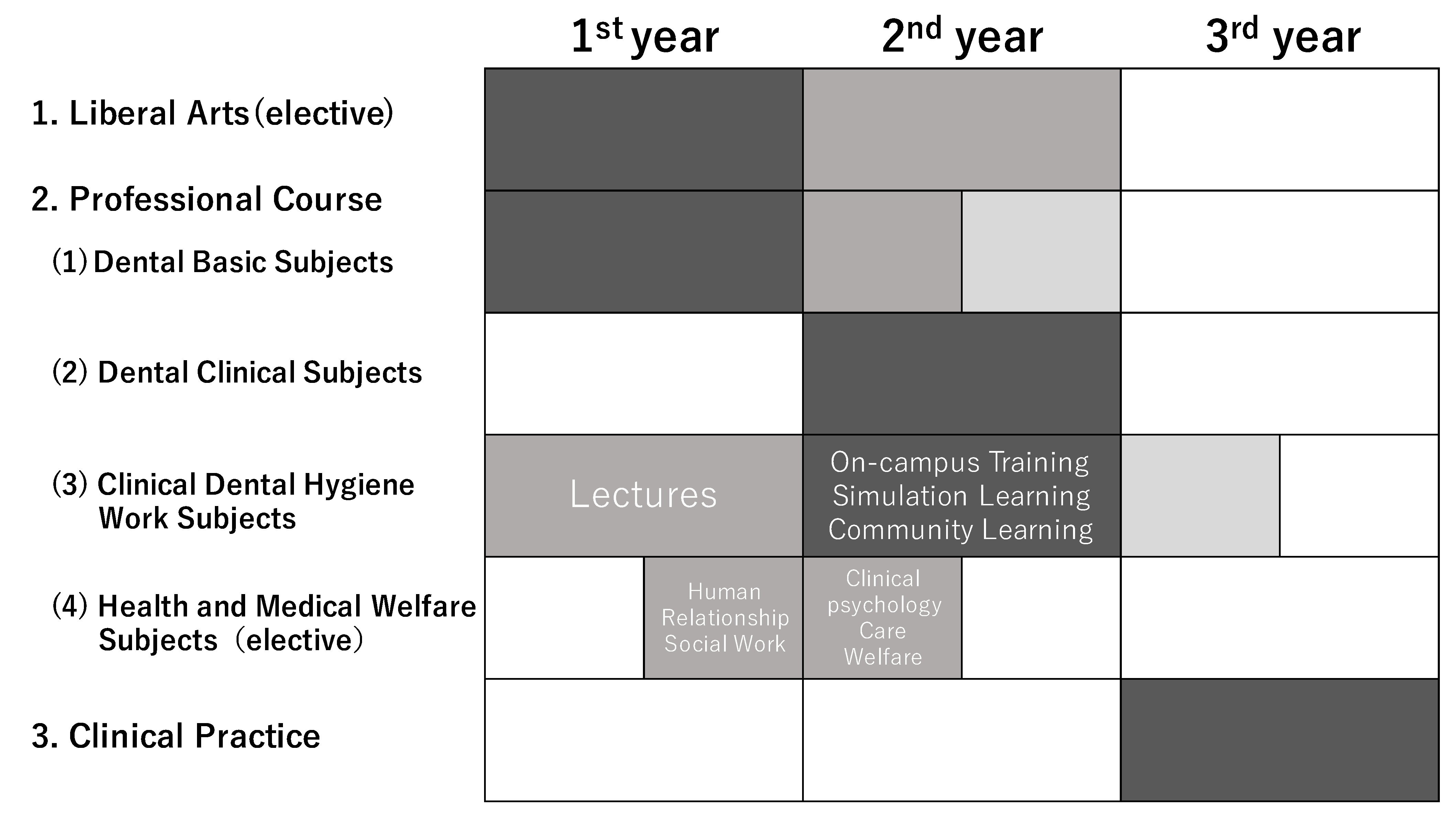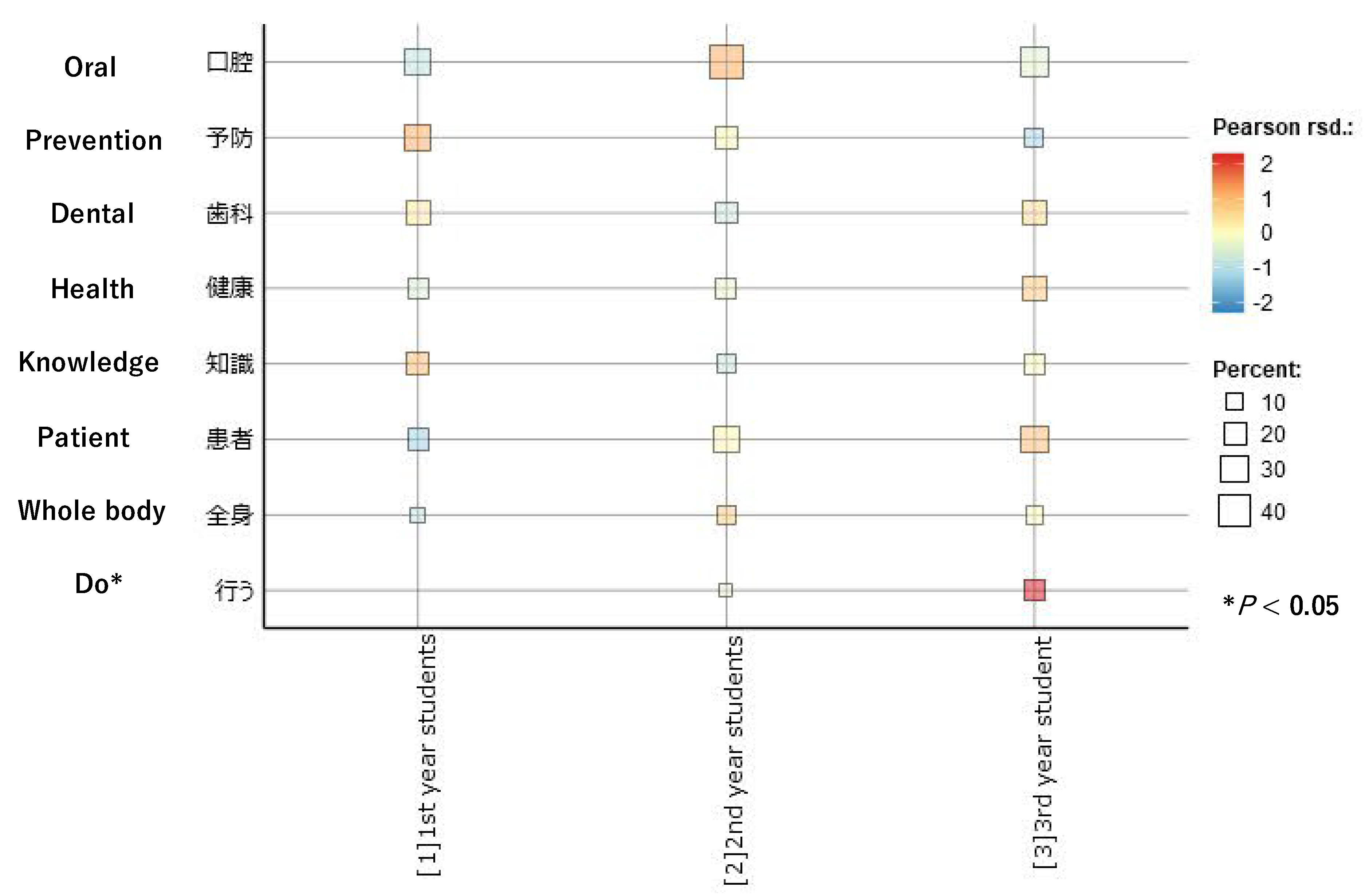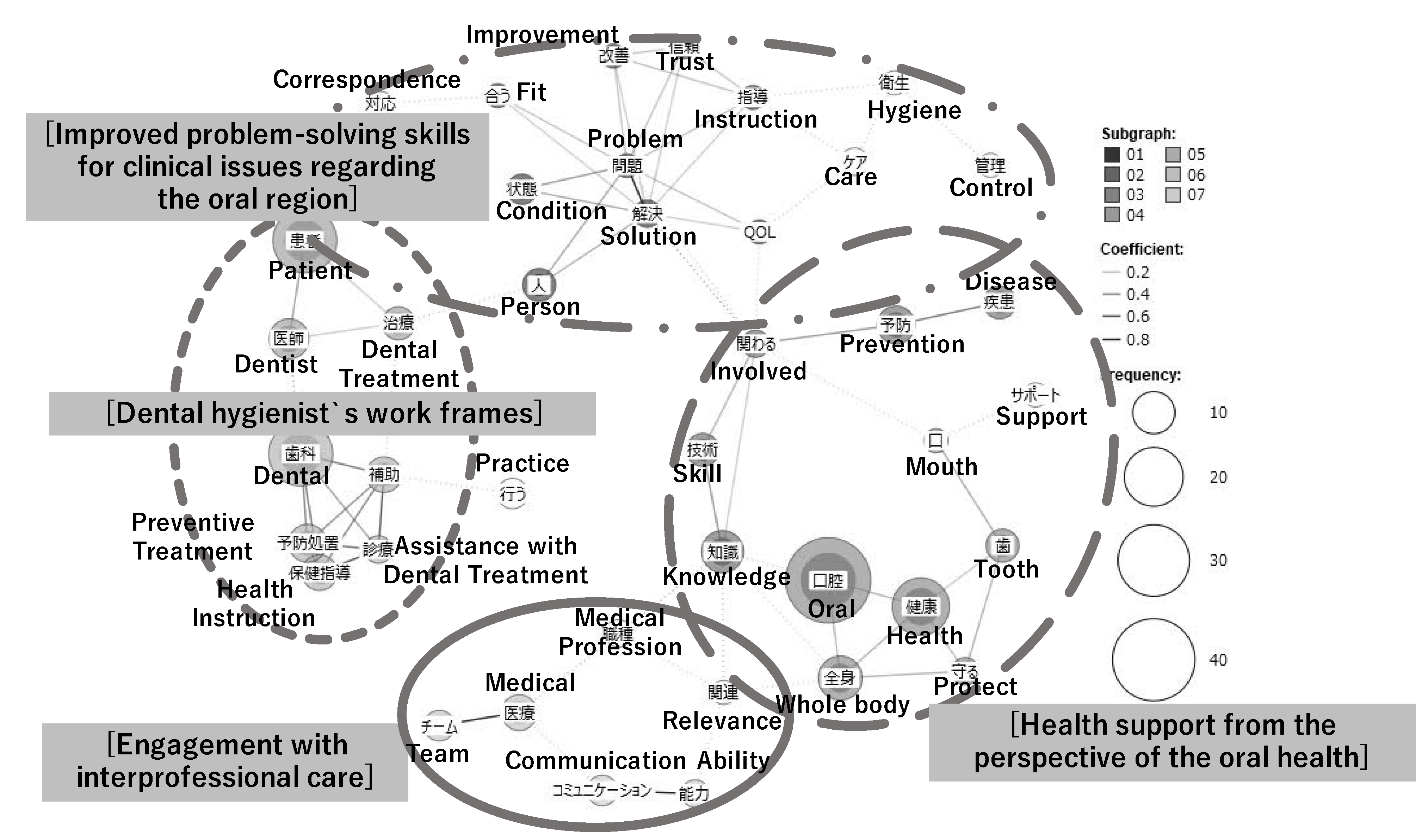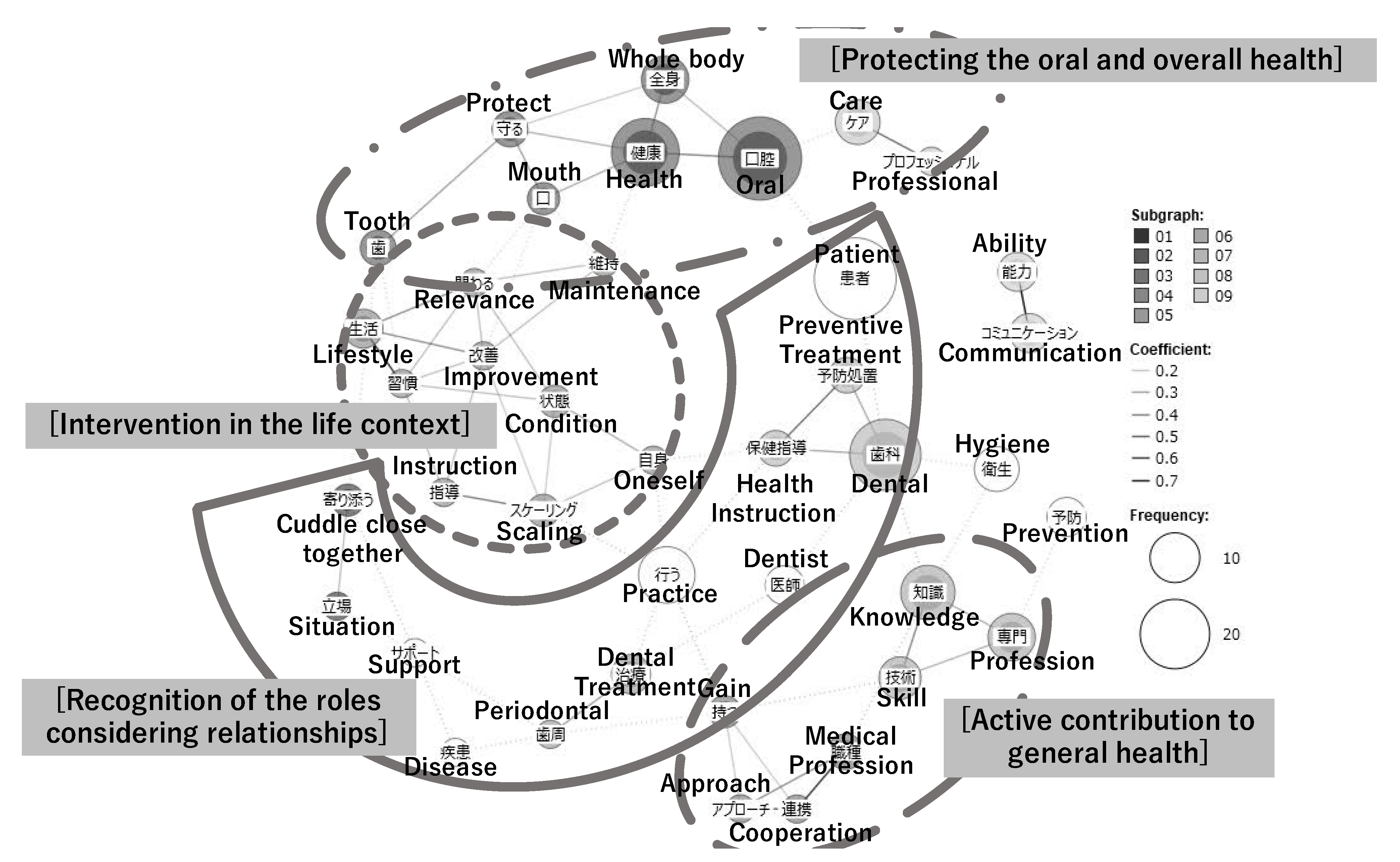Broadening the Dental Hygiene Students’ Perspectives on the Oral Health Professionals: A Text Mining Analysis
Abstract
1. Introduction
2. Materials and Methods
2.1. Participants
2.2. Data Collection
- -
- Why did you decide to become a dental hygienist?
- -
- What kind of dental hygienist do you want to be?
- -
- What do you think is the professionalism of dental hygienists?
- -
- What do you think is required of you as dental health professionals by society and patients?
- -
- What competencies do you think that dental hygienists need to have for clinical practice?
2.3. Data Analysis
2.4. Study Context
- -
- Professional knowledge, abilities, and communication skills related to dental hygiene
- -
- Logical thinking and problem-solving skills
- -
- Awareness of their roles and responsibilities as dental hygiene practitioners and the ability to perform them appropriately
- -
- A rich sense of humanity and high ethical standards, and ability to collaborate and cooperate with other professionals
- -
- Contribution to the development of people’s health and a striving for lifelong learning.
2.5. Ethical Considerations
3. Results
3.1. Changes in the Word Frequency
- Oral: 90 times
- Patient: 64 times
- Dental: 62 times
- Health: 51 times
- Knowledge: 35 times
3.2. Number of Code Occurrences
3.3. Code Occurrence Rate
3.4. Recognition of Professional Roles, Competence, and Attitude at the Three Time Points Based on the Strength of the Relationship between the Words
3.4.1. At the Beginning of the First Year’s Second Semester
Supporters at the Dental Clinic
- -
- “How to comfort the patients at the dental clinic, a place where they are considered to be uncomfortable”.
- -
- “Supporting the dental treatment to run smoothly”.
Understanding the Relationship between Oral and General Health
- -
- “Understanding better than anyone else that the teeth and oral health are linked to general health”.
- -
- “Dental caries prevention and understanding the relationship between the oral region and the whole body”.
- -
- “The ability to communicate the importance of oral health in various settings, both in the medical and educational fields”.
3.4.2. At the Beginning of the Second Year’s Second Semester
Dental Hygienists’ Work Frames
- -
- “Must be able to assist in the dental treatment, provide the oral health instruction, and perform the caries prevention procedures”.
- -
- “A person who can stand between the dentist and the patient and contribute to enhanced treatment”.
Engagement with Interprofessional Care
- -
- “To acquire an awareness of the whole body, not just the oral, and to be able to perform team medicine with other professionals”.
- -
- “Have a patient-centered attitude and the communication skills to practice in a team-based environment”.
Health Support from the Perspective of the Oral Health
- -
- “To improve the quality of life as well as the oral health of patients”.
- -
- “Promoting and maintaining general health through the oral health”.
Improved Problem-Solving Skills for Clinical Issues Regarding the Oral Region
- -
- “Perceive the patients’ condition, their oral health situation, understand their problems, and provide them with appropriate care to resolve those issues”.
- -
- “I think it is about improving oral health, instructing about oral health, and building trusting relationships to solve oral health problems”.
3.4.3. At the End of the Third-Year Clinical Practice
Active Contribution to General Health
- -
- “Dental as well as medical knowledge and working with various professionals to approach problems”.
- -
- “As a dental hygienist, we must have the knowledge to answer patient complaints”.
Recognition of the Roles Considering Relationships
- -
- “We are professionals in terms of prevention; thus, hygienists are required to provide care and prevention so that we do not get to the treatment stage”.
- -
- “To support the patients’ feelings (chief complaint) and to help them feel comfortable through the dentist”.
Protecting the Oral and Overall Health
- -
- “Improvement of the overall health and quality of life through oral health”.
- -
- “To enhance the quality of life by improving and maintaining oral health that is closely related to the everyday life, such as eating, speaking and laughing”.
Intervention in the Life Context
- -
- “To be able to provide health instruction from a dental perspective, including dietary instruction and lifestyle modification”.
- -
- “To provide instruction for the patients’ own oral health self-care, so that they themselves can maintain a good oral health”.
4. Discussion
5. Conclusions
Author Contributions
Funding
Institutional Review Board Statement
Informed Consent Statement
Data Availability Statement
Acknowledgments
Conflicts of Interest
References
- Jerkovic, K.; Van Offenbeek, M.A.; Slot, D.E.; Van Der Schans, C.P. Changes in the Professional Domain of Dutch Dental Hygienists. Int. J. Dent. Hyg. 2010, 8, 301–307. [Google Scholar] [CrossRef] [PubMed]
- Johnson, P.M. International Profiles of Dental Hygiene 1987 to 2006: A 21-Nation Comparative Study. Int. Dent. J. 2009, 59, 63–77. [Google Scholar] [PubMed]
- Inukai, J.; Sakurai, M.; Nakagaki, H.; Matsui, K.; Matsuda, H.; Tamura, K.; Danielsen, B.; Rowbotham, J.; Kosaka, T. Comparison of Clinical Practice Education in Dental Hygiene Schools in Eight Countries. Int. Dent. J. 2012, 62, 122–126. [Google Scholar] [CrossRef] [PubMed]
- Murai, A.; Nishikiori, R.; Jin, K. Investigation of Supply and Demand for Dental Hygienists in Japan. Shika Igaku J. Osaka Odontol. Soc. 2020, 83, 68–75. [Google Scholar]
- Kanazawa, N. Prospects and Subjects of Dental Hygienists -Aiming at the Coordination with Medical Care and Elderly Care. J. Jpn. Prosthodont. Soc. 2014, 6, 267–272. [Google Scholar] [CrossRef][Green Version]
- Yoshida, N.; Endo, K.; Komaki, M. Dental Hygiene Education in Japan: Present Status and Future Directions. Int. J. Dent. Hyg. 2004, 2, 179–184. [Google Scholar] [CrossRef]
- Nagatani, Y.; Imafuku, R.; Takemoto, T.; Waki, T.; Obayashi, T.; Ogawa, T. Dental Hygienists’ Perceptions of Professionalism are Multidimensional and Context-Dependent: A Qualitative Study in Japan. BMC Med. Educ. 2017, 17, 267. [Google Scholar] [CrossRef]
- Wong, A.; Trollope-Kumar, K. Reflections: An Inquiry into Medical Students’ Professional Identity Formation. Med. Educ. 2014, 48, 489–501. [Google Scholar] [CrossRef]
- Wenger, E. Communities of Practice: Learning, Meaning, and Identity; Cambrige University Press: Cambridge, UK, 1999. [Google Scholar]
- Larson, J.P. Formation of a Professional Identity as a Nurse: A Study of Nursing Values; University of South Dakota: Vermillion, SD, USA, 2016. [Google Scholar]
- Clements, A.J.; Kinman, G.; Leggetter, S.; Teoh, K.; Guppy, A. Exploring Commitment, Professional Identity, and Support for Student Nurses. Nurse Educ. Pract. 2016, 16, 20–26. [Google Scholar] [CrossRef]
- Crooks, D.; Carpio, B.; Brown, B.; Black, M.; O’Mara, L.; Noesgaard, C. Development of Professional Confidence by Post Diploma Baccalaureate Nursing Students. Nurse Educ. Pract. 2005, 5, 360–367. [Google Scholar] [CrossRef]
- Benner, P.; Sutphen, M.; Leonard, V.; Day, L. Educating Nurses: A Call for Radical Transformation; John Wiley & Sons: Hoboken, NJ, USA, 2009; Volume 15. [Google Scholar]
- Monrouxe, L.V. Identity, Identification and Medical Education: Why Should We Care? Med. Educ. 2010, 44, 40–49. [Google Scholar] [CrossRef]
- Matsuyama, Y.; Okazaki, H.; Kotani, K.; Asada, Y.; Ishikawa, S.; Lebowitz, A.J.; Leppink, J.; van der Vleuten, C. Professional Identity Formation-Oriented Mentoring Technique as a Method to Improve Self-Regulated Learning: A Mixed-Method Study. Asia Pac. Sch. 2021, 6, 49–64. [Google Scholar] [CrossRef]
- Browne, C.; Wall, P.; Batt, S.; Bennett, R. Understanding Perceptions of Nursing Professional Identity in Students Entering an Australian Undergraduate Nursing Degree. Nurse Educ. Pract. 2018, 32, 90–96. [Google Scholar] [CrossRef]
- Keselyak, N.T.; Simmer-Beck, M.; Bray, K.K.; Gadbury-Amyot, C.C. Evaluation of an Academic Service-Learning Course on Special Needs Patients for Dental Hygiene Students: A Qualitative Study. J. Dent. Educ. 2007, 71, 378–392. [Google Scholar] [CrossRef]
- Blue, C.M. Cultivating Professional Responsibility in a Dental Hygiene Curriculum. J. Dent. Educ. 2013, 77, 1042–1051. [Google Scholar] [CrossRef]
- Imafuku, R.; Nagatani, Y.; Yamada, S. Complexities of Interprofessional Identity Formation in Dental Hygienists: An Exploratory Case Study. BMC Med. Educ. 2022, 22, 8. [Google Scholar] [CrossRef]
- Koichi, H. Qualitative Text Analysis for Social Researchers: Contribution to Context Analysis; Nakanishiya Shuppan: Kyoto, Japan, 2014; p. 259. [Google Scholar]
- Sumathy, K.; Chidambaram, M. Text Mining: Concepts, Applications, Tools and Issues-an Overview. Int. J. Comput. Appl. 2013, 80, 29–32. [Google Scholar] [CrossRef]
- Kumar, L.; Bhatia, P.K. Text Mining: Concepts, Process and Applications. J. Glob. Res. Comput. Sci. 2013, 4, 36–39. [Google Scholar]
- Yu, C.H.; Jannasch-Pennell, A.; DiGangi, S. Compatibility Between Text Mining and Qualitative Research in the Perspectives of Grounded Theory, Content Analysis, and Reliability. Qual. Rep. 2011, 16, 730–744. [Google Scholar] [CrossRef]
- Guetterman, T.C.; Chang, T.; DeJonckheere, M.; Basu, T.; Scruggs, E.; Vydiswaran, V.G.V. Augmenting Qualitative Text Analysis with Natural Language Processing: Methodological Study. J. Med. Internet Res. 2018, 20, e231. [Google Scholar] [CrossRef]
- Jackson, D. Developing Pre-Professional Identity in Undergraduates Through Work-Integrated Learning. High Educ. 2017, 74, 833–853. [Google Scholar] [CrossRef]
- Park, J.J.; Chuang, Y.-C.; Hald, E.S. Identifying Key Influencers of Professional Identity Development of Asian International STEM Graduate Students in the United States. Asia-Pac. Edu. Res. 2018, 27, 145–154. [Google Scholar] [CrossRef]
- Dahlgren, M.A.; Hult, H.; Dahlgren, L.O.; af Segerstad, H.H.; Johansson, K. From Senior Student to Novice Worker: Learning Trajectories in Political Science, Psychology and Mechanical Engineering. Stud. High. Educ. 2006, 31, 569–586. [Google Scholar] [CrossRef]
- Healey, A.C.; Hays, D.G. A Discriminant Analysis of Gender and Counselor Professional Identity Development. J. Couns. Dev. 2012, 90, 55–62. [Google Scholar] [CrossRef]
- Dornan, T.; Littlewood, S.; Margolis, S.A.; Scherpbier, A.; Spencer, J.; Ypinazar, V. How Can Experience in Clinical and Community Settings Contribute to Early Medical Education? A BEME Systematic Review. Med. Teach. 2006, 28, 3–18. [Google Scholar] [CrossRef]
- Shikama, Y.; Chiba, Y.; Yasuda, M.; Stanyon, M.; Otani, K. The Use of Text Mining to Detect Key Shifts in Japanese First-Year Medical Student Professional Identity Formation Through Early Exposure to Non-Healthcare Hospital Staff. BMC Med. Educ. 2021, 21, 389. [Google Scholar] [CrossRef]
- Başak, O.; Yaphe, J.; Spiegel, W.; Wilm, S.; Carelli, F.; Metsemakers, J.F. Early Clinical Exposure in Medical Curricula Across Europe: An Overview. Eur. J. Gen. Pract. 2009, 15, 4–10. [Google Scholar] [CrossRef]
- Houlden, R.L.; Raja, J.B.; Collier, C.P.; Clark, A.F.; Waugh, J.M. Medical Students’ Perceptions of an Undergraduate Research Elective. Med. Teach. 2004, 26, 659–661. [Google Scholar] [CrossRef]
- Imafuku, R.; Saiki, T.; Kawakami, C.; Suzuki, Y. How Do Students’ Perceptions of Research and Approaches to Learning Change in Undergraduate Research? Int. J. Med. Educ. 2015, 6, 47–55. [Google Scholar] [CrossRef]
- Partido, B.B.; Chartier, E.A.; Heminger, B. Experiences and Attitudes of Dental Hygiene Faculty Regarding the Mentorship of Undergraduate Student Research. J. Dent. Educ. 2020, 84, 1202–1209. [Google Scholar] [CrossRef]
- Salinas-Miranda, A.A.; Shaffer-Hudkins, E.J.; Bradley-Klug, K.L.; Monroe, A.D. Student and Resident Perspectives on Professionalism: Beliefs, Challenges, and Suggested Teaching Strategies. Int. J. Med. Educ. 2014, 5, 87–94. [Google Scholar] [CrossRef] [PubMed]
- Wyatt, T.R.; Kleinheksel, A.J.; Tews, M. Linking Patient Care Ownership and Professional Identity Formation Through Simulation. Teach. Learn. Med. 2021, 33, 164–172. [Google Scholar] [CrossRef] [PubMed]
- Noble, C.; Coombes, I.; Nissen, L.; Shaw, P.N.; Clavarino, A. Making the Transition from Pharmacy Student to Pharmacist: Australian Interns’ Perceptions of Professional Identity Formation. Int. J. Pharm. Pract. 2015, 23, 292–304. [Google Scholar] [CrossRef] [PubMed]
- Cruess, R.L.; Cruess, S.R.; Boudreau, J.D.; Snell, L.; Steinert, Y. A Schematic Representation of the Professional Identity Formation and Socialization of Medical Students and Residents: A Guide for Medical Educators. Acad. Med. 2015, 90, 718–725. [Google Scholar] [CrossRef]
- Sarraf-Yazdi, S.; Teo, Y.N.; How, A.E.H.; Teo, Y.H.; Goh, S.; Kow, C.S.; Lam, W.Y.; Wong, R.S.M.; Ghazali, H.Z.B.; Lauw, S.K.; et al. A Scoping Review of Professional Identity Formation in Undergraduate Medical Education. J. Gen. Intern. Med. 2021, 36, 3511–3521. [Google Scholar] [CrossRef]
- Cruess, R.L.; Cruess, S.R.; Boudreau, J.D.; Snell, L.; Steinert, Y. Reframing Medical Education to Support Professional Identity Formation. Acad. Med. 2014, 89, 1446–1451. [Google Scholar] [CrossRef]
- Cooper, H.; Spencer-Dawe, E.; McLean, E. Beginning the Process of Teamwork: Design, Implementation and Evaluation of an Inter-Professional Education Intervention for First Year Undergraduate Students. J. Interprof. Care 2005, 19, 492–508. [Google Scholar] [CrossRef]
- Imafuku, R.; Kataoka, R.; Ogura, H.; Suzuki, H.; Enokida, M.; Osakabe, K. What Did First-Year Students Experience During Their Interprofessional Education? A Qualitative Analysis of e-Portfolios. J. Interprof. Care 2018, 32, 358–366. [Google Scholar] [CrossRef]
- Ministry of Health and Welfare, Japan. Dental Hygenist’s Act; Ministry of Health, Labour and Welfare: Tokyo, Japan, 1948. [Google Scholar]
- Annan-Coultas, D.; Borckardt, J.J.; Kascak, K.; Mauldin, M.; Scheurer, D.; Wise, H. Aligning Education with Collaborative Practice by Using Student Observations to Teach Interprofessional Teamwork. J. Allied Health 2021, 50, e79–e86. [Google Scholar]
- Davis, L.; Taylor, H.; Reyes, H. Lifelong Learning in Nursing: A Delphi Study. Nurse Educ. Today 2014, 34, 441–445. [Google Scholar] [CrossRef]
- Gardner, R. Introduction to Debriefing. Semin. Perinatol. 2013, 37, 166–174. [Google Scholar] [CrossRef]
- Rudolph, J.W.; Simon, R.; Raemer, D.B.; Eppich, W.J. Debriefing as Formative Assessment: Closing Performance Gaps in Medical Education. Acad. Emerg. Med. 2008, 15, 1010–1016. [Google Scholar] [CrossRef]






Publisher’s Note: MDPI stays neutral with regard to jurisdictional claims in published maps and institutional affiliations. |
© 2022 by the authors. Licensee MDPI, Basel, Switzerland. This article is an open access article distributed under the terms and conditions of the Creative Commons Attribution (CC BY) license (https://creativecommons.org/licenses/by/4.0/).
Share and Cite
Nagatani, Y.; Imafuku, R.; Nakai, Y. Broadening the Dental Hygiene Students’ Perspectives on the Oral Health Professionals: A Text Mining Analysis. Dent. J. 2022, 10, 160. https://doi.org/10.3390/dj10090160
Nagatani Y, Imafuku R, Nakai Y. Broadening the Dental Hygiene Students’ Perspectives on the Oral Health Professionals: A Text Mining Analysis. Dentistry Journal. 2022; 10(9):160. https://doi.org/10.3390/dj10090160
Chicago/Turabian StyleNagatani, Yukiko, Rintaro Imafuku, and Yukie Nakai. 2022. "Broadening the Dental Hygiene Students’ Perspectives on the Oral Health Professionals: A Text Mining Analysis" Dentistry Journal 10, no. 9: 160. https://doi.org/10.3390/dj10090160
APA StyleNagatani, Y., Imafuku, R., & Nakai, Y. (2022). Broadening the Dental Hygiene Students’ Perspectives on the Oral Health Professionals: A Text Mining Analysis. Dentistry Journal, 10(9), 160. https://doi.org/10.3390/dj10090160








